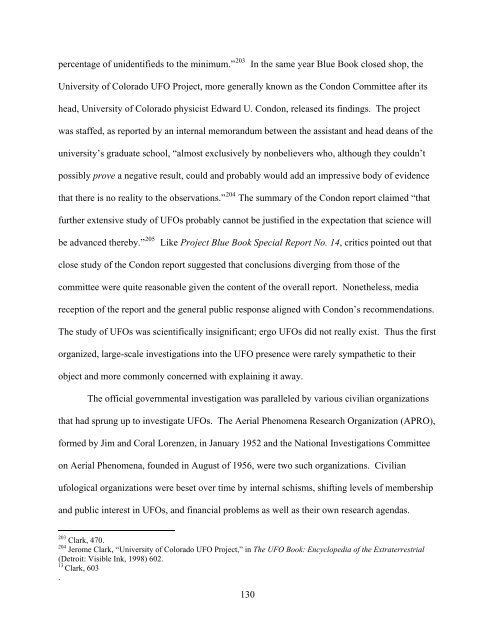A Genealogy of the Extraterrestrial in American Culture
A Genealogy of the Extraterrestrial in American Culture
A Genealogy of the Extraterrestrial in American Culture
You also want an ePaper? Increase the reach of your titles
YUMPU automatically turns print PDFs into web optimized ePapers that Google loves.
percentage <strong>of</strong> unidentifieds to <strong>the</strong> m<strong>in</strong>imum.” 203<br />
In <strong>the</strong> same year Blue Book closed shop, <strong>the</strong><br />
University <strong>of</strong> Colorado UFO Project, more generally known as <strong>the</strong> Condon Committee after its<br />
head, University <strong>of</strong> Colorado physicist Edward U. Condon, released its f<strong>in</strong>d<strong>in</strong>gs. The project<br />
was staffed, as reported by an <strong>in</strong>ternal memorandum between <strong>the</strong> assistant and head deans <strong>of</strong> <strong>the</strong><br />
university’s graduate school, “almost exclusively by nonbelievers who, although <strong>the</strong>y couldn’t<br />
possibly prove a negative result, could and probably would add an impressive body <strong>of</strong> evidence<br />
that <strong>the</strong>re is no reality to <strong>the</strong> observations.” 204 The summary <strong>of</strong> <strong>the</strong> Condon report claimed “that<br />
fur<strong>the</strong>r extensive study <strong>of</strong> UFOs probably cannot be justified <strong>in</strong> <strong>the</strong> expectation that science will<br />
be advanced <strong>the</strong>reby.” 205<br />
Like Project Blue Book Special Report No. 14, critics po<strong>in</strong>ted out that<br />
close study <strong>of</strong> <strong>the</strong> Condon report suggested that conclusions diverg<strong>in</strong>g from those <strong>of</strong> <strong>the</strong><br />
committee were quite reasonable given <strong>the</strong> content <strong>of</strong> <strong>the</strong> overall report. None<strong>the</strong>less, media<br />
reception <strong>of</strong> <strong>the</strong> report and <strong>the</strong> general public response aligned with Condon’s recommendations.<br />
The study <strong>of</strong> UFOs was scientifically <strong>in</strong>significant; ergo UFOs did not really exist. Thus <strong>the</strong> first<br />
organized, large-scale <strong>in</strong>vestigations <strong>in</strong>to <strong>the</strong> UFO presence were rarely sympa<strong>the</strong>tic to <strong>the</strong>ir<br />
object and more commonly concerned with expla<strong>in</strong><strong>in</strong>g it away.<br />
The <strong>of</strong>ficial governmental <strong>in</strong>vestigation was paralleled by various civilian organizations<br />
that had sprung up to <strong>in</strong>vestigate UFOs. The Aerial Phenomena Research Organization (APRO),<br />
formed by Jim and Coral Lorenzen, <strong>in</strong> January 1952 and <strong>the</strong> National Investigations Committee<br />
on Aerial Phenomena, founded <strong>in</strong> August <strong>of</strong> 1956, were two such organizations. Civilian<br />
ufological organizations were beset over time by <strong>in</strong>ternal schisms, shift<strong>in</strong>g levels <strong>of</strong> membership<br />
and public <strong>in</strong>terest <strong>in</strong> UFOs, and f<strong>in</strong>ancial problems as well as <strong>the</strong>ir own research agendas.<br />
203 Clark, 470.<br />
204 Jerome Clark, “University <strong>of</strong> Colorado UFO Project,” <strong>in</strong> The UFO Book: Encyclopedia <strong>of</strong> <strong>the</strong> <strong>Extraterrestrial</strong><br />
(Detroit: Visible Ink, 1998) 602.<br />
13<br />
Clark, 603<br />
.<br />
130















